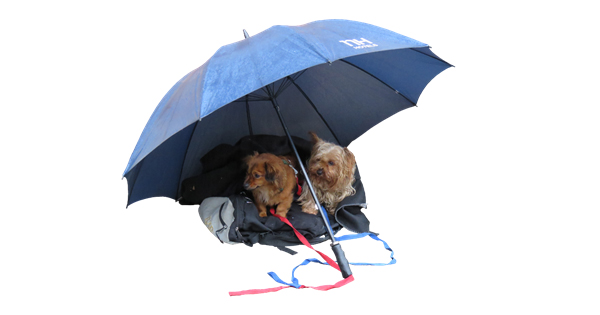An emergency kit ready for when disaster strikes is one of the best things you can provide for your dog
By Laura Pakis, Certified Dog Trainer and Professional Blogger
You never know when an emergency may arise. If and when disaster strikes, you don’t want to be searching for supplies let alone items your dog may need.
Packing a dog emergency kit and having an emergency plan in case of hurricane, flooding, summer wildfires, etc. is vital for you and your dog. You may never need to use it, but when recommendations for evacuation have been announced, having a kit ready and waiting will minimize evacuation time.
What is needed if you need to evacuate you home?
Here is what the Humane Society of the United States and ASPCA recommend:
- Food and water for at least 5-7 days for each dog along with bowls and a manual can opener if you feed canned food. Keep food stored in a cool, dry place where the temperature is between 50-degrees F to 100-degrees F. Vacuum sealing will preserve the food longer. Be sure to rotate the food every two months.
- Dog first aid kit and guide book along with medical records and 2-week supply of medications – all stored in a waterproof container (your veterinarian can help you with this). Remember to rotate medications otherwise they may go bad.
- Leash, harness or carrier to transport your dog safely and insure they don’t escape. Make sure your dog is wearing a collar and identification that is up to date and visible. Be sure to train your dog to use a crate prior to a disaster so they are not afraid of it. And label the crate with your dog’s name, your name, and how to find you. Including any important medical information would also be useful.
- Written information about your dog’s feeding schedule, medical conditions, behavior issues, name and number of your veterinarian along with a current photo of your dog and description of him. Keep this in a waterproof container. Be sure to update this data whenever the information changes. Also determine where you may take your dog in case you can’t bring him with you. Contact your local animal shelter to see if they provide emergency shelter or foster care for dogs. Check with hotels and motels outside your area for those that accept pets.
- Plastic storage tub, backpack or duffle bag to put all items above in.
If you have room, other useful items to include:
- Liquid dish soap and disinfectant
- Disposable garbage bags and poop bags for clean up
- Flashlight
- Blanket
- Paper towels
- Grooming tools
- Dog toys
- Microchipping your dog
Hopefully you will never have to use this kit. By planning for the worst-case scenario, you should be equipped for any disaster and have the peace of mind your dog will be ready as well.
Help protect pets by spreading the word about disaster preparedness. Download, print and share FEMA’s brochure today.
About the author: Having trained over 5,000 dogs and run a boarding and daycare facility for the past 13 years, Laura Pakis focuses her blog, Spike’s Dog Blog by Acme Canine, on training knowledge and the care and understanding of dogs.
A member of the Dog Writer’s Association, Blog Paws, Women in the Pet Industry and the IACP, Laura shares her experience through a variety of social medias and national and local magazines. She is an industry expert to the media and assists dog trainers worldwide with improving their training techniques, people skills, and business knowledge.
Well known throughout the canine community for quality training, high standards, and professionalism, Laura was nominated for the Woman of the Year in the Pet Industry, the BBB’s Integrity Award and Worthington, Ohio Chamber’s Small Business Person of the Year. Acme Canine received The Silver award for the 2014 Pet Age Boarding Facility of the year.
Laura can be heard on KSCOPetradio in San Jose, California every Sunday at 1pm sharing her canine knowledge.
Photo, above, provided by the author.
HAVE YOU SEEN THE PACCC PSA ON PET SAFETY? WATCH IT HERE.



